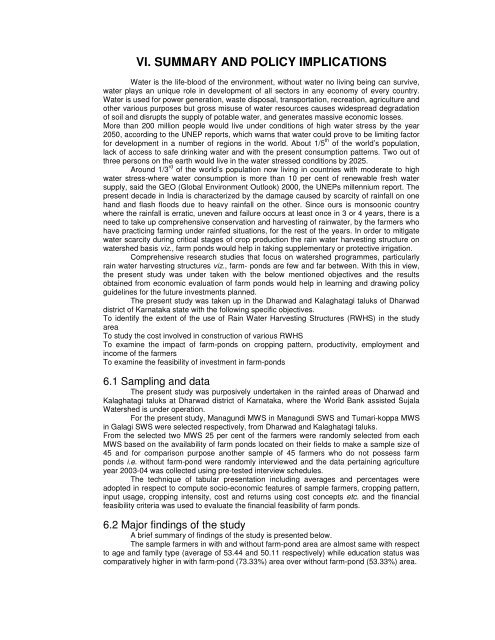Master of Science - ETD | Electronic Theses and Dissertations of ...
Master of Science - ETD | Electronic Theses and Dissertations of ...
Master of Science - ETD | Electronic Theses and Dissertations of ...
You also want an ePaper? Increase the reach of your titles
YUMPU automatically turns print PDFs into web optimized ePapers that Google loves.
VI. SUMMARY AND POLICY IMPLICATIONS<br />
Water is the life-blood <strong>of</strong> the environment, without water no living being can survive,<br />
water plays an unique role in development <strong>of</strong> all sectors in any economy <strong>of</strong> every country.<br />
Water is used for power generation, waste disposal, transportation, recreation, agriculture <strong>and</strong><br />
other various purposes but gross misuse <strong>of</strong> water resources causes widespread degradation<br />
<strong>of</strong> soil <strong>and</strong> disrupts the supply <strong>of</strong> potable water, <strong>and</strong> generates massive economic losses.<br />
More than 200 million people would live under conditions <strong>of</strong> high water stress by the year<br />
2050, according to the UNEP reports, which warns that water could prove to be limiting factor<br />
for development in a number <strong>of</strong> regions in the world. About 1/5 th <strong>of</strong> the world’s population,<br />
lack <strong>of</strong> access to safe drinking water <strong>and</strong> with the present consumption patterns. Two out <strong>of</strong><br />
three persons on the earth would live in the water stressed conditions by 2025.<br />
Around 1/3 rd <strong>of</strong> the world’s population now living in countries with moderate to high<br />
water stress-where water consumption is more than 10 per cent <strong>of</strong> renewable fresh water<br />
supply, said the GEO (Global Environment Outlook) 2000, the UNEPs millennium report. The<br />
present decade in India is characterized by the damage caused by scarcity <strong>of</strong> rainfall on one<br />
h<strong>and</strong> <strong>and</strong> flash floods due to heavy rainfall on the other. Since ours is monsoonic country<br />
where the rainfall is erratic, uneven <strong>and</strong> failure occurs at least once in 3 or 4 years, there is a<br />
need to take up comprehensive conservation <strong>and</strong> harvesting <strong>of</strong> rainwater, by the farmers who<br />
have practicing farming under rainfed situations, for the rest <strong>of</strong> the years. In order to mitigate<br />
water scarcity during critical stages <strong>of</strong> crop production the rain water harvesting structure on<br />
watershed basis viz., farm ponds would help in taking supplementary or protective irrigation.<br />
Comprehensive research studies that focus on watershed programmes, particularly<br />
rain water harvesting structures viz., farm- ponds are few <strong>and</strong> far between. With this in view,<br />
the present study was under taken with the below mentioned objectives <strong>and</strong> the results<br />
obtained from economic evaluation <strong>of</strong> farm ponds would help in learning <strong>and</strong> drawing policy<br />
guidelines for the future investments planned.<br />
The present study was taken up in the Dharwad <strong>and</strong> Kalaghatagi taluks <strong>of</strong> Dharwad<br />
district <strong>of</strong> Karnataka state with the following specific objectives.<br />
To identify the extent <strong>of</strong> the use <strong>of</strong> Rain Water Harvesting Structures (RWHS) in the study<br />
area<br />
To study the cost involved in construction <strong>of</strong> various RWHS<br />
To examine the impact <strong>of</strong> farm-ponds on cropping pattern, productivity, employment <strong>and</strong><br />
income <strong>of</strong> the farmers<br />
To examine the feasibility <strong>of</strong> investment in farm-ponds<br />
6.1 Sampling <strong>and</strong> data<br />
The present study was purposively undertaken in the rainfed areas <strong>of</strong> Dharwad <strong>and</strong><br />
Kalaghatagi taluks at Dharwad district <strong>of</strong> Karnataka, where the World Bank assisted Sujala<br />
Watershed is under operation.<br />
For the present study, Managundi MWS in Managundi SWS <strong>and</strong> Tumari-koppa MWS<br />
in Galagi SWS were selected respectively, from Dharwad <strong>and</strong> Kalaghatagi taluks.<br />
From the selected two MWS 25 per cent <strong>of</strong> the farmers were r<strong>and</strong>omly selected from each<br />
MWS based on the availability <strong>of</strong> farm ponds located on their fields to make a sample size <strong>of</strong><br />
45 <strong>and</strong> for comparison purpose another sample <strong>of</strong> 45 farmers who do not possess farm<br />
ponds i.e. without farm-pond were r<strong>and</strong>omly interviewed <strong>and</strong> the data pertaining agriculture<br />
year 2003-04 was collected using pre-tested interview schedules.<br />
The technique <strong>of</strong> tabular presentation including averages <strong>and</strong> percentages were<br />
adopted in respect to compute socio-economic features <strong>of</strong> sample farmers, cropping pattern,<br />
input usage, cropping intensity, cost <strong>and</strong> returns using cost concepts etc. <strong>and</strong> the financial<br />
feasibility criteria was used to evaluate the financial feasibility <strong>of</strong> farm ponds.<br />
6.2 Major findings <strong>of</strong> the study<br />
A brief summary <strong>of</strong> findings <strong>of</strong> the study is presented below.<br />
The sample farmers in with <strong>and</strong> without farm-pond area are almost same with respect<br />
to age <strong>and</strong> family type (average <strong>of</strong> 53.44 <strong>and</strong> 50.11 respectively) while education status was<br />
comparatively higher in with farm-pond (73.33%) area over without farm-pond (53.33%) area.
















